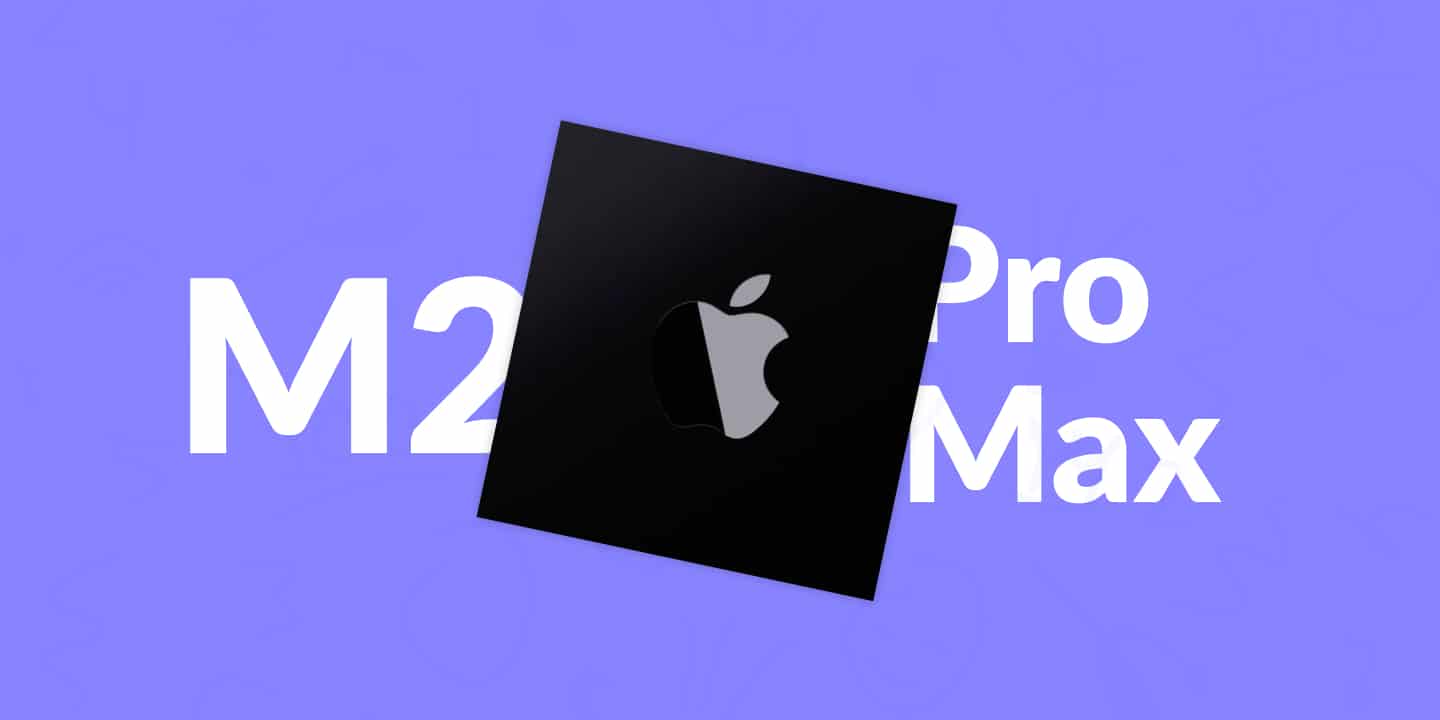👋 Great designs start with great feedback. That’s what Workflow is built for. Start today.
Home - UX Equipment - M2 Pro vs. M2 Max for UX
M2 Pro vs. M2 Max for UX
Should I get the M2 Pro or M2 Max for my new MacBook Pro? That’s a question many designers looking for a new laptop are asking themselves right now. An important choice to make! Here’s my M2 Pro vs. M2 Max buyer’s guide.
- Updated on January 28, 2023

Apple released new MacBooks at the start of 2023. The updated MacBooks now feature the M2 Pro and M2 Max chips and a few other minor upgrades.
Now that Apple is almost done phasing out Intel-powered Macs, picking the best Mac for UX design is easier than ever. For MacBook Pros, you no longer have to choose between Intel and Apple Silicon.

In a rush? Get the MacBook Pro with M2 Pro 👇
For UX designers, the M2 Pro is more than powerful enough to get the job done.
Table of Contents
Just last year, you could still choose a MacBook Pro with an Intel i7 or i9 and a MacBook Pro with the new M1 chip. All you have to do today is choose between different M2 options. These are the M2, M2 Pro, and M2 Max for laptops. If you’re considering a Mac Studio, you still have M1 options.
However, I’m mainly doing an M2 Pro vs. M2 Max comparison in this post. That’s because the base M2 chip isn’t powerful enough for heavy-duty design work. I always recommend laptops for UX designers, which also takes out the M1 Ultra.
For the remaining chips, I’ll compare the following.
- Benchmarks for gaming, video editing, and rendering.
- Battery life.
- M2 Pro vs. M2 Max differences.
M1 vs M1 Pro vs M1 Max vs M1 Ultra
| Chip | CPU cores | GPU cores | Neural Engine |
|---|---|---|---|
| M1 | 8-core | 8-core | 16-core |
| M1 Pro | 8 or 10-core | 14 or 16-core | 16-core |
| M1 Max | 10-core | 16, 24, or 32-core | 16-core |
| M1 Ultra | 20-core | 48 or 64-core | 32-core |
| M2 | 8-core | 10-core | 16-core |
| M2 Pro | 10 or 12-core | 16 or 19-core | 16-core |
| M2 Max | 12-core | 38-core | 16-core |
Let’s take a look at the different M2 versions available today. When comparing the chips, I will ignore the other specs that would normally be important in buying a new laptop, like RAM, storage, and screen size. Instead, the focus is entirely on the M2 Pro and M2 Max.
Before I do, let’s take a look at the different variables. Apple Silicon chips are called SoC. SoC stands for system-on-a-chip. There are multiple computer components on one chip instead of each component having its spot on the motherboard, like in the old days.
In Apple’s case, all versions of Apple Silicon consist of three elements:
- The CPU. The central processor for your daily tasks. It is the brain of your machine.
- The GPU, also known as the graphics card, is responsible for visual calculations in design tools.
- The Neural Engine. This engine has a machine learning focus within MacOS. It takes tasks away from the main CPU to save energy.
When comparing Apple Silicon chips, you’ll notice that they all have several cores available for each of the three components mentioned above. The base M2, for example, has an 8-core CPU and a 10-core GPU, regardless of the configuration you choose. It also has one 16-core Neural Engine.
If you move one step up, you’ll see that the M2 Pro has two variations. It has either a 10-core CPU and a 16-core GPU or a 12-core CPU and a 19-core GPU. The strongest M2 Max has a 12-core CPU and a 38-core GPU.
Picking the best chip out of the M2 Pro and M2 Max is a question of how far you want to go and how much raw power you need for your UI and UX design work.
Comparing the M2 Pro and M2 Max (and M1 chips)
Let’s do the M2 Pro vs. M2 Max comparison! And since you can still get some M1-equipped Macs, I’ll also include those in the comparison.
The new M2 Max performs better than a $50,000 Mac Pro.
This is an impressive performance since the new MacBook requires less power and claims to do 21 hours on a single charge. By the way, compared to the 2019 Intel MacBook Pro, the M2 Max is more than twice as powerful (multi-core score of 6167 vs. 15127).
Benchmark
To do a better M1 and M2 comparison, we have to benchmark them based on a multiscore. Whenever you’re looking for a benchmark in tech, chances are you’ll end up at GeekBench. So let’s pull up some of the scores in the table below.
Only the M1 scores lower than the final Intel-powered MacBook Pro. However, it is far more efficient, has better battery life, and has a lower price tag. The M1 and M2 Pro, M1 and M2 Max, and M1 Ultra beat the i9 without any issues.
| Chip | Score |
|---|---|
| Intel i9-9880H (MacBook Pro) | 6,313 |
| M1 (MacBook Pro) | 4,403 |
| M1 Pro (MacBook Pro) | 9,413 |
| M1 Max (MacBook Pro) | 12,703 |
| M1 Ultra | 22,681 |
| M2 | 8,974 |
| M2 Pro (10-core) | 12,111 |
| M2 Max | 15,280 |
Only the M1 scores lower than the final Intel-powered MacBook Pro. However, it is far more efficient, has better battery life, and has a lower price tag. The M1 and M2 Pro, M1 and M2 Max, and M1 Ultra beat the i9 without any issues.
Battery life
Up next is the battery life comparison of both M1 and M2 chips. In theory, the Pro chips have slightly better battery life. They’re less powerful and therefore use less power.
If you look at test results on websites like MacRumors and Reddit, you’ll see that it is accurate. The M1 Pro has a slightly better battery life than the M1 Max.
I have an M1 Pro MacBook Pro. After using the M1 Pro for work, I still had about 20% of battery life left after 9 hours of sharing my screen, video calls, and working on my design prototype. That’s better than any other Mac I’ve ever had. And with the new M2 chips, this should only improve more.
M2 Pro vs M2 Max. Which one should I get?
Let’s make your choice somewhat easier. For UI and UX design, I recommend skipping the base M2 laptop. It means only the M2 Pro and M2 Max remain. Go for the M2 Pro. It is more than powerful enough and has better battery life. You don’t need the M2 Max to run Figma.
If your work also involves some video editing, the M2 Max might be worth it for you. Here’s the Mac we recommend.
16-inch MacBook Pro M2 Pro
UI, UX, and product designers will have more than enough computing power when they pick the 16-inch MacBook Pro with the 12-core CPU.

The MacBook Pro 16-inch is more expensive than the 14-inch version, but with extra cores and a larger screen, it is worth the additional investment. You can upgrade to have more cores if you want, but that’s optional. You don’t need it per se.
Both versions of this machine have all the benefits of the new M2 Pro chip, including high-speed performance and excellent battery life.
Get yours below.
Further reading
These are exciting times for any UI and UX designer working on a Mac. The new MacBook Pros are great. You only have to choose between M2 Pro or M2 Max.
Honestly, I think the M2 Max is too much for any designer. You can save a lot of money by purchasing the M2 Pro Mac. Please take a look at my post on picking the best Mac for UX design for my complete buyer’s guide.
👋 Turn good design to great design, with feedback you actually need. Get it on Workflow.

About the author
Hi! I'm Nick Groeneveld, a senior designer from the Netherlands with experience in UX, visual design, and research. I'm a UX coach that supports other designers and have completed design projects in finance, tech, and the public sector.
☎️ Book a 1:1 mentor meeting or let's connect on LinkedIn and Twitter.



